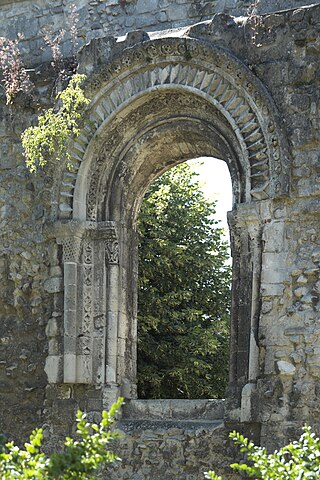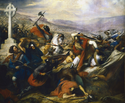Related Research Articles

Charlemagne was King of the Franks from 768, King of the Lombards from 774, and Emperor of what is now known as the Carolingian Empire from 800, holding all these titles until his death in 814. Charlemagne succeeded in uniting the majority of Western and Central Europe, and was the first recognized emperor to rule in the west after the fall of the Western Roman Empire approximately three centuries earlier. Charlemagne's rule saw a program of political and social changes that had a lasting impact on Europe in the Middle Ages.

Louis the Pious, also called the Fair and the Debonaire, was King of the Franks and co-emperor with his father, Charlemagne, from 813. He was also King of Aquitaine from 781. As the only surviving son of Charlemagne and Hildegard, he became the sole ruler of the Franks after his father's death in 814, a position that he held until his death except from November 833 to March 834, when he was deposed.
The 830s decade ran from January 1, 830, to December 31, 839.
The 780s decade ran from January 1, 780, to December 31, 789.

The year 771 (DCCLXXI) was a common year starting on Tuesday of the Julian calendar. The denomination 771 for this year has been used since the early medieval period, when the Anno Domini calendar era became the prevalent method in Europe for naming years.

Carloman I, also Karlmann, Karlomann, was king of the Franks from 768 until he died in 771. He was the second surviving son of Pepin the Short and Bertrada of Laon and was a younger brother of Charlemagne. His death allowed Charlemagne to take all of Francia and begin his expansion into other kingdoms.
Himiltrude was the mother of Charlemagne's first-born son Pippin the Hunchback. Some historians have acknowledged her as the wife of Charlemagne, however, she is often referred to as a concubine.

Paschasius Radbertus (785–865) was a Carolingian theologian and the abbot of Corbie, a monastery in Picardy founded in 657 or 660 by the queen regent Bathilde with a founding community of monks from Luxeuil Abbey. His most well-known and influential work is an exposition on the nature of the Eucharist written around 831, entitled De Corpore et Sanguine Domini. He was canonized in 1073 by Pope Gregory VII. His feast day is April 26. His works are edited in Patrologia Latina vol. 120 (1852) and his important tract on the Eucharist and transubstantiation, De Corpore et Sanguine Domini, in a 1969 edition by B. Paulus, published by Brepols.

Pepin or Pippin was King of Italy from 781 until his death in 810. Born Carloman, he was the third son of Charlemagne. Carloman was renamed Pepin upon his baptism in 781, where he was also crowned as king of the Lombard Kingdom his father had conquered. Pepin ruled the kingdom from a young age under Charlemagne, but predeceased his father. His son Bernard was named king of Italy after him, and his descendants were the longest-surviving direct male line of the Carolingian dynasty.

Adalard of Corbie was the son of Bernard who was the son of Charles Martel and half-brother of Pepin; Charlemagne was his cousin. He is recognised as a saint within the Roman Catholic and Eastern Orthodox Church.

Hildegard was a Frankish queen and the wife of Charlemagne from c. 771 until her death. Hildegard was a noblewoman of Frankish and Alemannian heritage. Through eleven years of marriage with Charlemagne, Hildegard helped share in his rule as well as having nine children with him, including the kings Charles the Younger and Pepin of Italy and the emperor Louis the Pious.
Charles the Younger was the son of the Frankish ruler Charlemagne and his wife Queen Hildegard. Charlemagne's second son, Charles gained favour over his older, possibly illegitimate half brother Pepin. Charles was entrusted with lands and important military commands by his father. In 800, Charlemagne was crowned emperor by Pope Leo III, and during this ceremony Charles was anointed a king. Charles was designated as the heir of the bulk of Charlemagne's lands but predeceased his father, leaving the empire to be inherited by his younger brother Louis the Pious.

Corbie Abbey is a former Benedictine monastery in Corbie, Picardy, France, dedicated to Saint Peter. It was founded by Balthild, the widow of Clovis II, who had monks sent from Luxeuil. The Abbey of Corbie became celebrated both for its library and the scriptorium.
The Count of Vermandois was the ruler of the county of Vermandois.
The Patrimony of Saint Peter originally designated the landed possessions and revenues of various kinds that belonged to the apostolic Holy See. Until the middle of the 8th century this consisted wholly of private property; later, it corresponded to the territories under Papal sovereignty, but from the early 13th century the term was applied to one of the four provinces of the States of the Church.
Wala was a son of Bernard, son of Charles Martel, and one of the principal advisers of his cousin Charlemagne, of Charlemagne's son Louis the Pious, and of Louis's son Lothair I. He succeeded his brother Adalard as abbot of Corbie and its new daughter foundation, Corvey, in 826 or 827. His feast day is 31 August

Notre-Dame de Soissons was a nunnery dedicated to the Virgin Mary in Soissons. It was founded during the Merovingian era, between 658 and 666, but the community was dissolved and the building partially demolished during the French Revolution (1789–99).
The royal household of the early kings of the Franks is the subject of considerable discussion and remains controversial. This discussion is aimed at identifying the major categories of participants in the administration and those who made the major historical impacts. Every king of the Franks from Clovis I to Charles the Bald had a large cadre of advisors and bureaucrats that helped implement their regime. These supporters of the crown are frequently unknown, but often are ancestors of the later rulers of France. This is not intended to be a complete list of those supporting the kings but to serve as a guide for further study. A general discussion of the Merovingian and Carolingian dynasties can be found in the associated main articles. See also Government of the Carolingian Empire.
Hieronymus (Jerome), was the son of Charles Martel and his mistress, and so was the half-brother of Bernard, Abbot of St. Quentin, a key confidant of Louis the Pious, and Remigius, the third Archbishop of Rouen.
Autchar was a Frankish nobleman. He served Pippin III as a diplomat in 753 and followed Carloman I after the division of the kingdom in 768. In 772, refusing to accept Carloman's brother Charlemagne as king, he went into exile in the Lombard kingdom with Carloman's widow and sons. He was captured when Charlemagne invaded the kingdom in 773. His role in the fall of the Lombard kingdom was the subject of legendary embellishment a century later and in the chansons de geste he evolved into the figure of Ogier the Dane.
References
- ↑ Jackman, Donald C.. Three Bernards Sent South to Govern United States, Editions Enlaplage, 2015. p. 8 ISBN 9781936466115
- ↑ Frassetto, Michael (2003). Encyclopedia of Barbarian Europe: Society in Transformation. Santa Barbara, CA: ABC-CLIO. p.142 ISBN 978-1-57607-263-9
- ↑ Mombert, Jacob Isidor. A History of Charles the Great, D. Appleton, 1888, p.90
- ↑ Becher, Matthias. Charlemagne United Kingdom, Yale University Press, 2003. p. 55 ISBN 9780300107586
- ↑ Confronting Crisis in the Carolingian Empire: Paschasius Radbertus' Funeral Oration for Wala of Corbie (Justin Lake, Mayke de Jong, eds.) United Kingdom, Manchester University Press, 2020. p.17 ISBN 9781526134837
- 1 2 Bring-Gould, Sabine. "S. Ida, W.", The Lives of the Saints, J. Hodges, 1882, p.50
- ↑ Sismondi, Jean-Charles-Léonard Simonde. The French Under the Merovingians United Kingdom, W. & T. Piper, 1850. p. 285
 This article incorporates text from this source, which is in the public domain .
This article incorporates text from this source, which is in the public domain .



